The Veerayatan Ashram At Rajgir
Offering help to the needy is common to all Jaina sects. The above featured eye camp was conducted by a Digambara community. Some weeks later, at Rajgir in Bihar our last place of sojourn on our way to Parishnatha Hill, we found hos pitable lodging and board in the Vecrayatan Ashram run by nuns belonging to the Sthanakavini denomination.
The first time we stayed in this ‘Socio-religious Institute, as it is designated in a brochure, happened to be early in 1989.
At that time the late Muni Amar Maharaj was still alive. It was he who in a dream saw how at Rajgir, that historic place where Mahavira spent many a rainy season, an oasis of truly religious life was meant to come into being.
It was a young nun who dedicated her life to the not easy task of making Muni Amar’s dream a reality.
She would hardly have succeeded, in spite of her exceptional abilities, had it not been for the adherence of many Jainas to the last of the five Great Vows cited above (pages 20 and 213) and named aparigrahavrata, meaning “voluntarily setting a limit to one’s possessions and spending any income above the set limit on matters of religion and clarity”.
Without this continuous flow of donations this socio-religious casis could not have grown and flourished the way it did in so short a time.
Once the purchase of a large plot of waste land at the western outskirts of Rajgir was completed, the then 36-year-old Sadhvi Chandana – since her fourteenth year a nun- laid the foundation of Veerayatan. It was the auspicious day of Parshva natha’s birthday in 1973. The spiritual guidance continued to come from Muni Amar Maharaj who stayed at Rajgir till his death in 1992
Considering today’s remoteness and rather neglected state of Rajgir- of old it was a famous royal city and an important commercial centre – Sadhvi Chandana, now respected by her subordinate nuns and her many lay followers as Acharya Shri Chandanaji, accomplished a miracle.
With in a few years her Temple of Worship-a modem eye hospital-was built. Sthanakavasi Jainas, it should be noted, do not have temples By the time of our second visit carly in 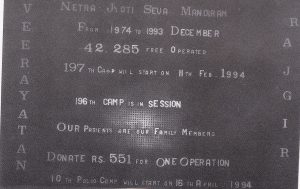 1994, over 43.000 eye surgeries had been performed in this hospi tal of a hundred beds. Of late, the medical service has been extended to polio and
1994, over 43.000 eye surgeries had been performed in this hospi tal of a hundred beds. Of late, the medical service has been extended to polio and
Blackboard in the Veeryaratan Eye Hospital showing the number of completed operations
orthopaedic patients. Artificial limbs, spectacles and medicines, and all operations and treatments are free of charge. Almost all patients – over a hundred each month- are non-Jainas. Their introduction to the religion of non-violence is the common greeting of each new day by listening to the melodious voice of Sadhvi Sumati Kunwar.
Veerayatan of Rajgir, started and built up by just five dedicated nuns – by 1995 their number had grown to ten- “is the first Jaina institution where the concept of service to mankind is not only preached by monks and nuns but also practised by them.
Visitors of all creeds and nationalities are welcome. Two long rows of guest-rooms, set in a garden of trees and flowers at the foot of the historic Vaibhara Hill, and a number of other facilities ensure a comfortable and peaceful stay. Elderly inhabitants of Rajgir remember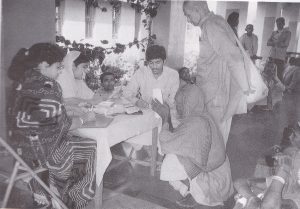 this area as a hide-out of criminal gangs All this has been changed by a muni’s dream and the vision and determination of a Jaina nun
this area as a hide-out of criminal gangs All this has been changed by a muni’s dream and the vision and determination of a Jaina nun
Veerayatan Charitable Eye Hospital, Rajgir. Men, women and children from near and far queue up for admission. The token fee is Rs. 2/-
“What makes Vecrayatan even more impressive is that it was set up due to the dedication of five Jaina nuns who worked in virtual isolation as there was no Jaina community anywhere nearby to support them morally. Furthermore, they managed to transform not only the location into a paradise but also the hostile attitude of the local people. Today Veerayatan is a major source of livelihood for many locals from clerical staff to gardeners and from cooks to washerwomen.” From an article by Payal Kumar in The Hindustan Times, Feb. 5, 1995
- Quoted from an Verayatan publication.
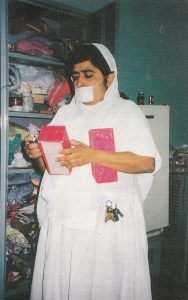
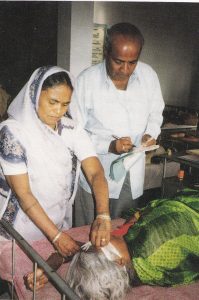 Veerayatan Eye Hospital, Rajgir. Daily routine competently attended to by the medical staff and local people trained at the hospital. Sadhvi Chetna (above), holding a diploma in allopathic medicine (obtained after she became a nun), is the affectionate and serene ‘mother superior’. Motivation and dedication are the key to this admirable Temple of Worship’. Pure vegetarian food is supplied by the hospital.
Veerayatan Eye Hospital, Rajgir. Daily routine competently attended to by the medical staff and local people trained at the hospital. Sadhvi Chetna (above), holding a diploma in allopathic medicine (obtained after she became a nun), is the affectionate and serene ‘mother superior’. Motivation and dedication are the key to this admirable Temple of Worship’. Pure vegetarian food is supplied by the hospital.
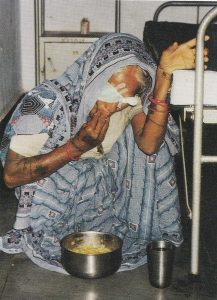 The Indian woman is the living embodiment of peace, service and devotion. She holds the torch-light of humanity in this dark world. Her heart overflows with love, compassion, forbearance and fortitude. She scatters flowers in place of thorns.
The Indian woman is the living embodiment of peace, service and devotion. She holds the torch-light of humanity in this dark world. Her heart overflows with love, compassion, forbearance and fortitude. She scatters flowers in place of thorns.
Muni Gurudev Amar
(From his book Amar Vani, 1988: 139)
